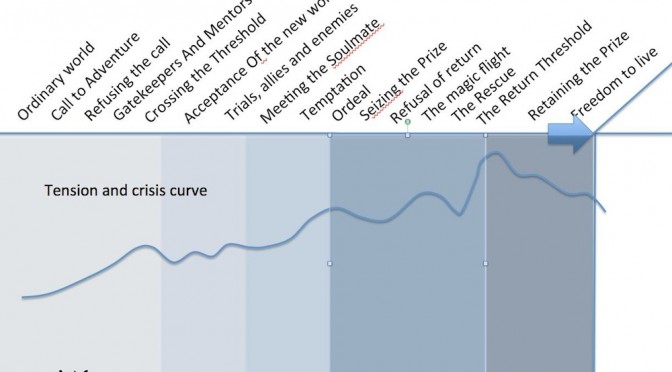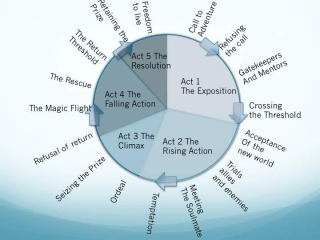 Integration with the Five Acts
Integration with the Five Acts
I intend to use the five act Structure for all the books. I came to prefer this structure after studying the work of Joseph Campbell and his “Heroes Journey” and subsequently reading Christoper Vogler.Vogler found himself resorting to four acts in his book “The Writers Journey’.
I have experimented with that but moved on because the five act structure works so much better for the action based novels I write.
I have not abandoned concepts of the heroes journey as I believe “events” of the “Heroes Journey” help as milestones for many many structural issues.
The five acts are as follows:-
Act 1 Exposition
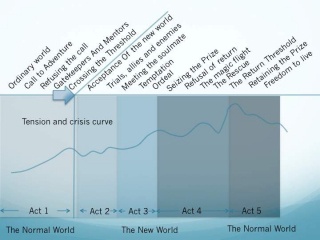 The tension curve, Act One And the hero's journeyThe exposition provides the background information needed for a reader to properly understand the story, such as the protagonist, the antagonist, the basic conflict, and the setting.
The tension curve, Act One And the hero's journeyThe exposition provides the background information needed for a reader to properly understand the story, such as the protagonist, the antagonist, the basic conflict, and the setting.
It Introduces the characters, shows some of their interrelationships, and places them within a time and place.
Introduces the main character(s) our hero(s), the dramatic premise, and the dramatic situation.
At the end of Act I, the hero(s) makes decisions to confront his issues instead of avoiding them. This is called called the inciting moment, which is the incident without which there would be no story.
The inciting moment sets the remainder of the story in motion beginning with the second act, the rising action.
Act 2 Progress and Challenges
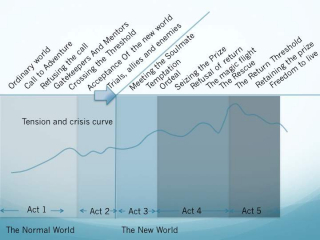 The tension curve, Act Two And the hero's journeyDuring rising action, we see the first plot point or event that sets the plot in motion.
The tension curve, Act Two And the hero's journeyDuring rising action, we see the first plot point or event that sets the plot in motion.
The basic conflict is complicated by the introduction of related secondary conflicts, including various obstacles.
Secondary conflicts can include adversaries of lesser importance than the story’s antagonist, who may work with the antagonist or separately.
At some point in the Rising action, our hero takes on the problem. The rising action is the path toward the confrontation where our hero has to acquire and use new skills ( specific to this story:- The skills Ximene sets out to acquire are completely different to those acquired by John. They both have their own journey)
Act 3 Achievements and Threats
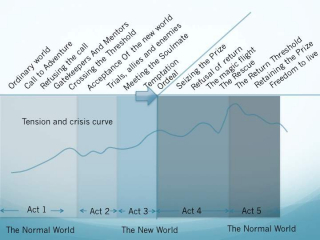 The tension curve, Act Three And the hero's journeyThe third act is that of the climax, or turning point, which marks a change, for the better or the worse, in the protagonist’s affairs.
The tension curve, Act Three And the hero's journeyThe third act is that of the climax, or turning point, which marks a change, for the better or the worse, in the protagonist’s affairs.
If the story is a comedy, things will have gone badly for the protagonist up to this point. If the story is a tragedy, the opposite state of affairs will ensue, with things going from good to bad for the protagonist.
Note that the Climax is not a ‘point’ in the five act structure but a whole series of events
First Culmination
A point just before the halfway where our hero seems close to achieving his goal/objective but fails. It is where everything falls apart, leading to the midpoint.
Midpoint
Is a point approximately halfway where our hero reaches his lowest point and seems farthest from fulfilling the dramatic need or objective.
The Second Culmination
Our hero progresses towards his ultimate goal which is the final confrontation with the antagonist.
The point at which the plot reaches maximum tension and the opposing forces confront each other.
Act 4 The Decisive Conflict
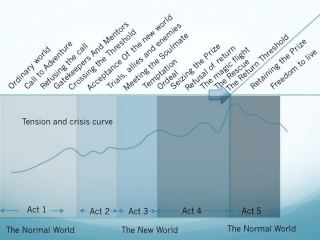 The tension curve, Act Four And the hero's journeyThis period is shorter than the rising action.
The tension curve, Act Four And the hero's journeyThis period is shorter than the rising action.
It is where we start tying up the loose ends. During the falling action, or the subsequent resolution, the conflict between the protagonist and the antagonist unravels, with the protagonist winning or losing against the antagonist.
The falling action might contain a moment of final suspense, during which the final outcome of the conflict is in doubt.
Summary: The falling action is that part of the story in which the main part (the climax) has finished and you’re heading to the conclusion.
Act 5 Outcomes
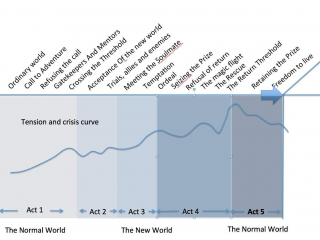 The dénouement comprises events between the falling action and the actual end of the drama or narrative and thus serves as the conclusion of the story.
The dénouement comprises events between the falling action and the actual end of the drama or narrative and thus serves as the conclusion of the story.
Conflicts are resolved, creating normality for the characters and a sense of catharsis, or release of tension and anxiety.
In a comedy, the protagonist is better off than at the story’s outset.
A tragedy ends with a catastrophe in which the protagonist is worse off than at the beginning of the narrative.
There is a period of calm at the end where a state of equilibrium returns.
The main character has changed.
The “story question” is answered.
The Heroines Journey
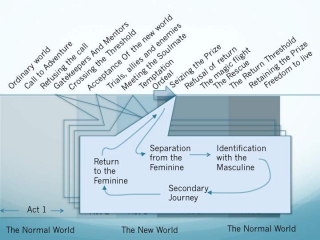 The Heroine's JourneyIf one of the Protaganists is Female it is necessary to listen to Maureen Murdoch as well as Joseph Campbell and Vogler. Murdoch studied with Campbell but struggled with some of his concepts.
The Heroine's JourneyIf one of the Protaganists is Female it is necessary to listen to Maureen Murdoch as well as Joseph Campbell and Vogler. Murdoch studied with Campbell but struggled with some of his concepts.
‘You always write about the Hero’s journey’ she asked Campbell, ‘what about the Heroine’s Journey? The answer staggered her. ‘The heroine is the object of the Hero’s Journey’, Campbell answered, adding ‘She doesn’t go anywhere, she is what the Hero is journeying to.’ It was at this point that Murdoch decided she should do some work on her own account. (Atlanta Jungian Society 2010)
Maureen Murdoch identifies that the female version of the hero’s journey is different (and far more complex) from the male journey, mainly in that although at the start of the journey she must separate from the feminine she needs periodically to return to the feminine to restore her strength, purpose and direction. Each one of these cycles can be a journey in its own right.
